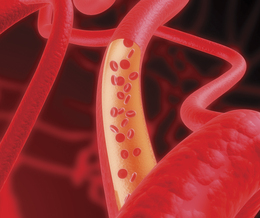
Peripheral Arterial Disease affects nearly 10 million Americans. More commonly referred to as PAD, this disease of the arteries does not discriminate. It affects men and women of any race or ethnicity. While it is more commonly diagnosed in those over 50 years old, PAD can be identified in people young and old.
Led by Dr. James F. McGuckin Jr., founder and chief executive officer of Vascular Access Centers, the Peripheral Vascular Institute of Philadelphia (PVIP) is on the forefront in treating PAD—a debilitating condition that can be successfully treated. According to Dr. McGuckin, “Over the past five years, we have seen a great number of technological advances that have changed the dynamics of treatment. No longer do patients require major surgery in order to resume regular activity.”
Simply defined, PAD is a clogging or narrowing of the arteries that carry blood to the arms and legs. The disrupted flow of blood, which most commonly affects the lower extremities, can cause pain, but in many patients PAD may be symptomless. For those who do show symptoms, they can easily be attributed to other conditions or simply a matter of aging. As a result, many cases are never diagnosed.
One of the most prevalent signs of PAD is leg pain that strikes during any physical activity, such as walking or exercising. “Many patients have to sit down after any physical exertion to alleviate the pain,” McGuckin says. Other symptoms include numbness, tingling or coldness in the lower legs and feet. Some patients may have ulcers and sores to the lower extremities that do not heal.
Like many diseases, there are certain medical conditions and lifestyle choices that can increase the likelihood of PAD. Smoking is one such risk factor as is high cholesterol, high blood pressure and diabetes. Those who live a rather inactive lifestyle and do not engage in a structured exercise regimen are also at risk.
“Due to the silent nature of PAD, I encourage those at high risk to be tested,” says McGuckin. “If you are unsure, ask yourself: ‘Are you able to walk five blocks without stopping? Do you experience foot or toe pain that disturbs your sleep? Are your toes or feet pale, discolored or bluish?’ These are just some of the questions found on our quick yes-or-no online questionnaire to help.”
“With the advancements in arterial therapies related to PAD, there is no reason to avoid treatment,” McGuckin says. “So many of those suffering with this disease simply adapt to the pain or discomfort but they don’t have to any longer. If you or your doctor think you may have signs of PAD, it is best to be checked.”
At the initial appointment with PVIP, patients undergo a complete physical and the well-trained staff documents their medical history and symptoms. This is followed by a non-invasive test that takes less than 30 minutes, and results are generally available within 24 to 48 hours. Patients whose results show positive for PAD are provided with a recommended treatment plan based upon their individual case.
“Changes in lifestyle, such as smoking cessation and a structured exercise program, are at times all that’s needed to alleviate symptoms and prevent further progression of the disease,” McGuckin says.
For those who require more extensive therapy, Dr. McGuckin and his team perform a minimally invasive treatment that combines angioplasty and stenting. Through a bandage-sized incision at the groin, a catheter is threaded through the femoral artery to the narrow or blocked artery. The blood vessel is opened with a small inflated balloon and, if needed, it can be held open with a tiny metal stent. Either way, the outpatient surgery is complete within two hours and after a couple of hours of recovery patients are able to return home. In most cases the second leg is done in a subsequent session.
After the treatment, patients may experience mild soreness at the site of incision. They will often be prescribed an anti-platelet medication, such as Plavix, and the staff will provide directions for retraining the muscles once they are working again. PVIP will conduct an annual follow-up test to confirm that no further treatment is needed.
“It is amazing that we can enter through the smallest of incisions yet do such big things,” McGuckin says.
“When I turned 92, I danced with an Elvis Presley impersonator at my surprise birthday party,” says Gaynell Lineberry, a 96-year-old patient in Portageville, Mo. “At 95, I was diagnosed with Peripheral Arterial Disease and didn’t think I would ever dance again. I had an ulcer on my foot that would not heal, and I was told that I may have to have my foot amputated. After visiting the Vascular Access Center, my foot is now getting the blood flow it needs to heal and I know that my dancing days aren’t over yet.”
As part of the Vascular Access Centers network, PVIP is one of 21 locations throughout the United States, providing focused care resulting in the best possible outcomes. Vascular Access Centers offer an alternative setting for vascular procedures, and its professionals are some of the top experts in their respective field—handling vascular access to maintain function, preservation and restoration for each individual patient’s condition.
In addition to Peripheral Arterial Disease, PVIP treats patients who require complete catheter services and new, temporary or tunneled catheter placement. The team also provides central venous access with chest and arm ports, uterine-fibroid embolization and varicose-vein treatment.
“At Vascular Access Centers our goal is to achieve enhanced patient care through clinical excellence and unparalleled service,” McGuckin explains. It’s about improving one’s quality of life and giving back a patient’s independence.”
He adds, “To this day, the joy of saving a person’s foot or leg is remarkable, and after 14 years my passion continues to grow.”
Peripheral Vascular Institute of Philadelphia
4220 Market Street, Philadelphia
215-240-6007
VascularAccessCenters.com
Monday - Friday 8 a.m. to 4 p.m.
Glori Gayster is a freelance writer and marketing professional based in South Jersey.


